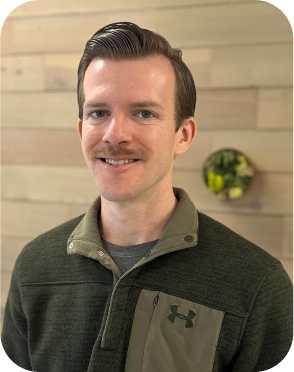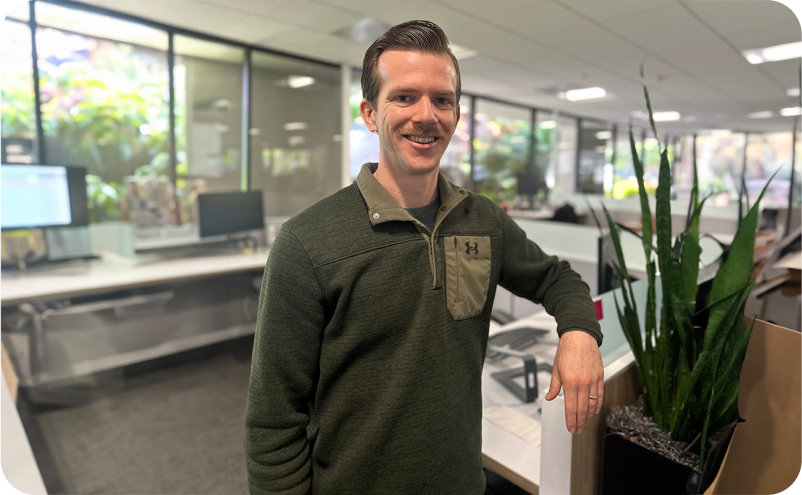What connects the brilliant minds that shape the future of AI at Uniphore? A thirst to learn more—no matter where their journey takes them. From exploring (and subsequently leading) emerging fields, like machine learning, to laying the groundwork for several of today’s leading language-based AI applications, our industry-leading team brings together a unique blend of skills, backgrounds and experiences. For many, the path to AI innovation started well outside of the industry—and occasionally outside of the field itself.
 Before pursuing a career in AI, Tanner Sorensen, Senior AI Scientist at Uniphore, studied linguistics. Fascinated by languages, his journey began at the University of Nebraska, where he graduated in 2013 with a degree in German Language and Literature. He then moved to Germany, where he received a master’s degree in Linguistics at the University of Potsdam. From there, it was back to the states, where he completed his PhD at the University of Southern California. (Did we mention that our team travels a lot?)
Before pursuing a career in AI, Tanner Sorensen, Senior AI Scientist at Uniphore, studied linguistics. Fascinated by languages, his journey began at the University of Nebraska, where he graduated in 2013 with a degree in German Language and Literature. He then moved to Germany, where he received a master’s degree in Linguistics at the University of Potsdam. From there, it was back to the states, where he completed his PhD at the University of Southern California. (Did we mention that our team travels a lot?)
Where did the jump to AI happen? “When I did my Master’s in Germany, my advisor was a member of a laboratory called Haskins Lab,” Tanner shared in a recent Teams call. “That’s a place where they do a lot of speech production and speech perception research, like how humans produce and perceive speech. That connection eventually led me to the University of Southern California [and its] Signal Analysis Interpretation Lab.”
USC’s Signal Analysis Interpretation Lab (SAIL) is an interdisciplinary lab focused on human-centered signal and information processing. Working alongside electrical and computer engineers, Tanner became increasingly involved in the technical applications of linguistics. His experience opened his eyes to the immense potential of linguistics in language technology—and to a future in speech-based AI.
“[Being around] mostly engineers and computer scientists, I think it was a bit of osmosis that I started to understand what opportunities were available, I think something like 90 percent or more of the graduates of SAIL went into the [language technology] industry in some way.”
Tanner Sorensen, Senior AI Scientist
Tanner would too. Shortly after completing his PhD, he joined Cobalt Speech & Language, a custom speech and language solutions provider founded by Jeff Adams. If that name sounds familiar, it should. Adams was founding manager of Amazon’s Alexa speech group which developed the platform’s original ASR and NLU. While at Cobalt, Tanner worked as a research scientist, developing systems for natural language understanding and question answering from knowledge graphs.
After nearly two years of largely research-based work for bespoke, language-based solutions, Tanner was ready for something bigger. He had heard from another SAIL alumni who worked at Uniphore about the company’s reputation as an enterprise AI leader and its employee-empowered culture. After digging a little deeper, he soon realized that this is where he could make the biggest impact on the future of language technology.
“This is a company where you get to work on real products that impact a lot of people,” he said. “Coming from a smaller company, which was doing more research-type work, it’s not as big of a footprint in terms of the impact that makes. At Uniphore, it’s a more defined domain and a much larger user base.”

As Senior AI Scientist at Uniphore, Tanner has been highly instrumental in developing several new capabilities for the company’s U-Product portfolio. Most recently, he has worked on a method of summarization as question-answering (vs. generic summarization) and an LLM-based automatic evaluation method for summarization. (Stay tuned to our blog for more on these innovations.)
When asked what drives innovation at the product level, Tanner reveals that it’s a balance of emerging capabilities and evolving customer needs. Using the example of generative AI, which has unleashed a wealth of capabilities—some already in use; countless others yet to be realized—he sheds light on how his team approaches the subject:
“Customers are starting to define their own requirements in terms of generative AI, they’re using it to create their own dream of what would make their job easier. It then becomes our job to figure out how do we meet that customer need.”
Tanner Sorensen, Senior AI Scientist
Given the speed at which that need can shift, AI developers must not only be agile; they must anticipate what customers will need and want. They must be able to read their dreams for clues that can make their experience better—for their customers, their agents and their wider enterprise. Fortunately, Uniphore has built a team that thrives on asking, “what next?” and peering well ahead of the curve. And with leaders like Tanner developing the next generation in language-based AI, tomorrow’s customer needs are already being solved today.
)